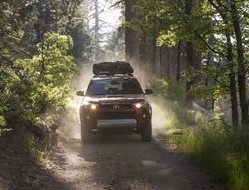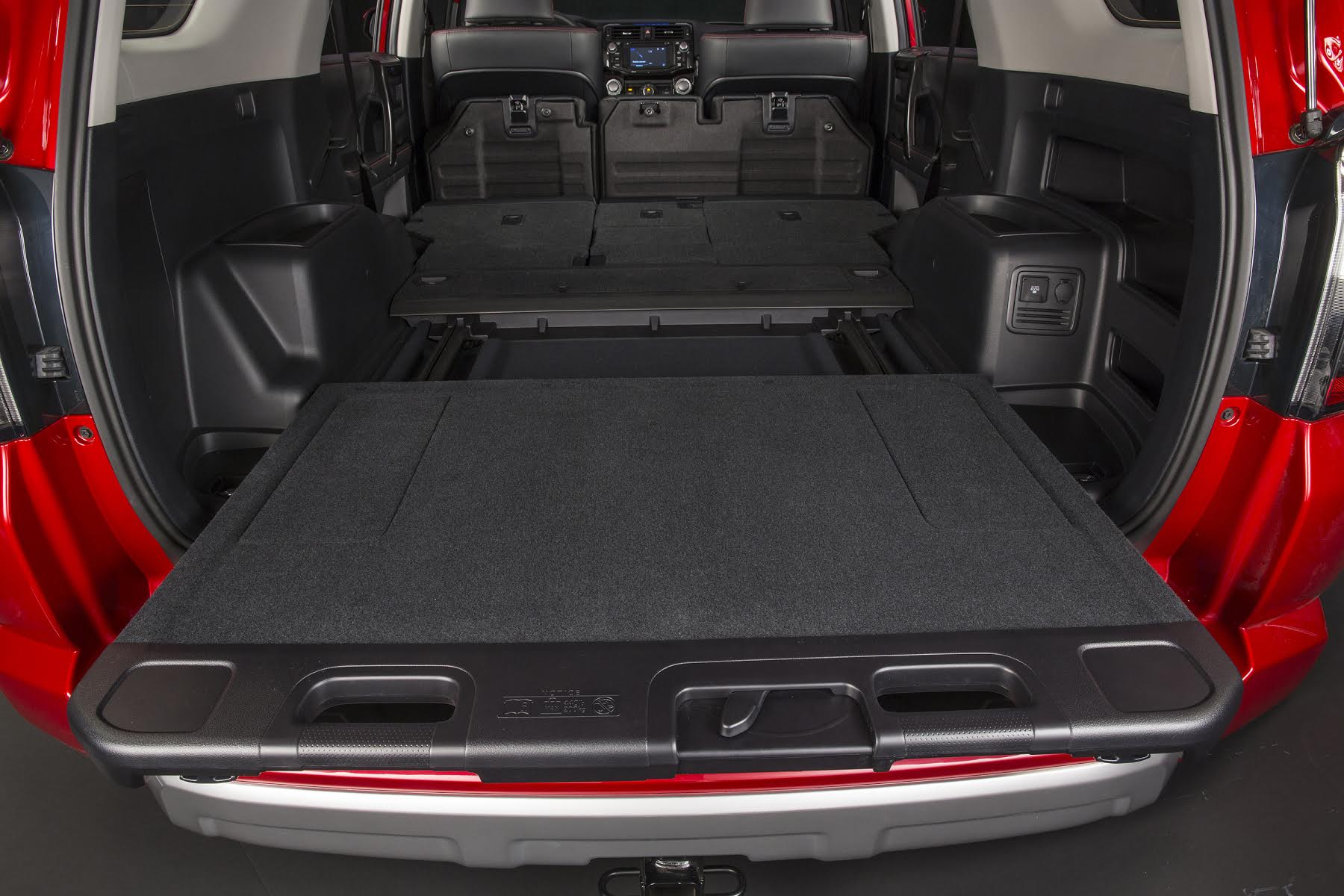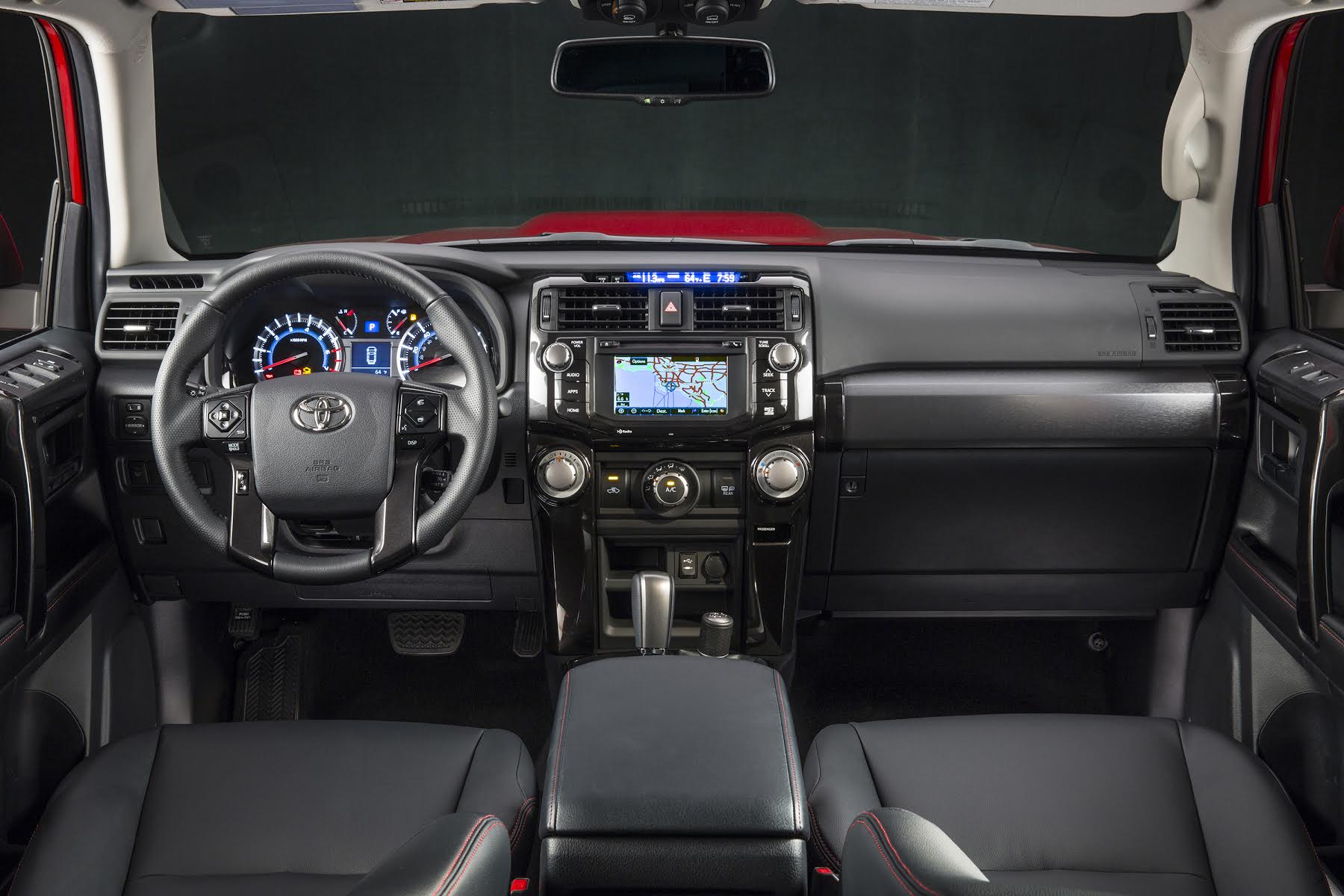Grandson’s Great Day Is Grandpa’s Embarrassment
The usual modus operandi at Clean Fleet Report is to evaluate hybrid, plug-in hybrid, electric and fuel-efficient vehicles. But when Toyota offered a 4Runner for a week, I said yes because I had what seemed was a good idea at the time. In retrospect it was a good idea, things just didn’t work out in the manner I had envisioned.

The plan was to take my youngest grandson, Gherit, for a day of off-roading at a large Weyerhaeuser-owned forest southwest of Olympia. I have been driving the logging roads of this massive timberland for more than 30 years. My first experience was in 1995 when I laid out a test drive route for the second annual Northwest Sport Utility Vehicle (SUV) Of The Year for the Northwest Automotive Press Association that became known as “Mudfest.”
Most of the logging roads are gravel and can be driven slowly in an everyday passenger car. However, if you look hard enough, there are some narrow, rutted and rugged trails. Granted, our Toyota 4Runner TRD (Toyota Racing Development) 4X4 Premium, with its sparkling Barcelona Red Metallic paint job, was over qualified for the terrain, but the ambiance was ideal for Gherit’s first off-highway foray.
How Much Over-Qualified for the Gravel Logging Roads?
Starting from the ground up were 17-inch NittoTerra Grapler tires, a 9.6-inch ground clearance, 33-degree approach angle, 26-degree departure angle, Bilstein shocks to absorb off-road rambles, plus extra skid-plating. All 4Runner models feature a coil-spring independent front suspension with a stabilizer bar, and a solid axle out back suspended by a four-link setup with coil springs and a stabilizer bar. Our 4Runner added Toyota’s optional Kinetic Dynamic Suspension System (KDSS), which increases suspension travel at low speeds to improve stability on rocky terrain. A multi-terrain Crawl Control and hill assist are standard.

The four-wheel drive setup is a manually selectable two-speed transfer case with a low-range setting. A locking rear differential is standard.
In other words, this TRD 4Runner thumbs its nose at rough terrain.
My Oh My, Things Change Over the Years
I’ve driven the logging roads and trails in the Weyerhaeuser forest 30 or 40 times, but not in the last three years. When the asphalt turned into gravel, it was about three miles to the road I wanted. But dang!, about 15 yards short of the junction was a blockade gate, and no way around. O.K., things change over the years, but we had passed three or four other roads, so we’ll just go back.
Blockade gates greeted us on the first two roads after driving about a mile. The third road appeared to be the right choice. This logging road circles the perimeter of the forest with lots of off-shoot trails. Things were great for six miles, then another gate. Well, it’s turn around again (not the easiest thing to do in the 4Runner) and head for another off-road area I know about 15 miles away.
As we slowly made our way back, looking for a trail or road, Gherit suddenly said, “Hey, there’s a trail.” I back up and, sure enough, there’s a small opening among the trees that I had missed. I poked the 4Runner’s nose through the brush and could see a narrow, rugged, twisty trail that went steeply downhill into a mud hole, and then flattened out before heading upwards towards a hard right. This was just what the 2017 Toyota 4Runner TRD 4X4 was made for.
Gherit, We’re Going to Have Fun!
I slipped the transfer case into 4-Low and eased down the hill and through the mud hole, thinking, “Why is there water and mud, it hasn’t rained in weeks.” Then I recalled that the forest was full of springs.
As we toddled up the hill and made the hard right turn and slowly worked our way forward, it became obvious that this wasn’t an ordinary logging trail. It was extremely narrow, hilly, rutted, and filled with very tight turns. About a mile in, we stopped in a clearing for lunch and pulled the outside mirrors in. The forest was alive with birds flitting through the tree branches and singing whenever they stopped for a rest. Gherit wore a constant smile. Mission accomplished.

We were making small talk when I remembered one of the cardinal rules of off-roading: Always have a companion vehicle just in case something goes wrong. But I had not intended to be on a trail like this and Gherit was so enjoying himself that I decided to continue.
Another mile or so brought us around a narrow corner that looked straight at an enormous muddy water hole. The left side was slightly sloped and there was solid ground down the middle separating the ruts, but no way to go around. I could have backed up a few yards and manage to turn around, but Gherit wanted to continue forward. This is when I disregarded another cardinal rule: Get out of the vehicle and check what’s in front, in this case, how deep water-filled ruts where.
I decided I could straddle the ruts, put the left tires on the slope, and inch forward. That worked for about 10 feet, then the 4Runner slid to the right and we became high centered. No amount of placing wood under the right tires would budge the off roader. Embarrassment describes how I felt.
Well, I’d just have to make some phone calls and find a towing company to come winch us out. Big problem, no cell service.
After locking things up, we began our walk to find a cell signal. It was nearly five miles before we came across one of the scattered homes. There were people in the yard who graciously drove us to a junction were I could begin making calls. By now it was late afternoon and the tow company I located that agreed to the task couldn’t make it until the next morning. That left us waiting for two hours on the side of a road for my wife to pick us up. And Gherit? He thought the whole day was one of the best he’s ever had.
About The 4Runner
The 2017 Toyota 4Runner is a traditional body-on-frame midsize sport-utility vehicle with a solid rear axle. Five-passenger seating is standard, with an optional third row offered in rear- or four-wheel-drive configurations. The original 4Runner dates way back to 1984 as a compact SUV that was little more than a Toyota pickup truck with a fiberglass shell over the bed.
As then, today’s edition is purpose-built for off-roading and is best for drivers who spend much of their time off the beaten path. It’s outfitted for dirt-trails and rock crawling like nothing this side of a Jeep Wrangler. The 2017 Toyota 4Runner is one of the few remaining body-on-frame midsize SUVs in the U.S. with low-range four-wheel-drive available and, the only one offered with third-row seating. in the U.S.
Yes, the 4Runner is basically a truck, but that doesn’t mean the ride is unbearable or uncivilized. While it delivers a noticeably firm ride, the spring and suspension settings are not so primitive as to render it incapable of delivering acceptable levels of cornering and comfort. Due to its weight and high ride height, our 4Runner couldn’t round curves like a midsize crossover SUV, but its narrow body was a bit easier to maneuver than a full-size SUV, at least in urban surroundings.
An annoying weak spot did show up during our week with the 4Runner. The brake pedal at first felt a bit soft, and after applying more pressure, caused the brakes to grab too quickly.
The only engine available is a 4.0-liter V-6 with variable valve timing. This is a proven power plant that pumps out 270 horsepower and 278 pounds-feet of torque. It never felt quick in this big, heavy beast, but the power always delivered when merging into freeway traffic or needing to pass a slower vehicle.
In today’s automotive world, the five-speed automatic transmission may seem outdated, but it worked well and seemed well synced to the V-6. However, fuel economy stinks, and that’s where a six-speed auto (or an eight-speed like some of its competition) could help. I got just 18.3 mpg after driving 375 miles with a mix of city, highway and off-roading. The EPA rates this at 17-mpg city/20 highway/18 combined.
Exterior and Interior
Last redesigned for the 2014 model year, the 4Runner’s looks are eye-catching with a controversial front-end styling update. No matter your thoughts, there’s no denying that the SUVs looks best with a splash or two of mud and muck. It’s their natural element.
The 2017 Toyota 4Runner stays true to sport-utility tradition, which dictates a truck front end and a wagon body. Boxy and slab-sided, the 4Runner favors function over form. It sits high off the ground and rides on tires with big, rock-absorbing side walls, adding to its brawny look. The aggressively slanted headlights and available blacked-out grille mean that the front end, at least, can look mean and modern. The roll-down rear window is a classic 4Runner trait not found in many other vehicles.

Inside, the 4Runner’s blocky dashboard seems like a throwback to pickups from the 1990s. The majority of the cabin’s surfaces are hard, meant to take a beating. Not necessarily cheap or brittle, mind you, but chosen with durability and easy cleaning rather than comfort or tactile pleasure in mind. Everything is well-fitted and assembled.
As you might expect, the driving position is commanding, and the driver grips a thick, oversized steering wheel. Large windows and a high seating position contribute to good outward visibility with few blind spots. Controls are sensibly-arrayed, large, easy-to-reach and easily operated even when wearing gloves. Off-road-focused controls are located in an overhead console, keeping the center stack of controls straightforward and accessible. A secondary display sits atop the center stack, and redundant steering wheel controls access audio and Bluetooth functions.
Power-adjustable front seats are well supported and a tilt/telescoping steering wheel makes it easy to find the right driving position. Several large, deep cubbies in the front row mean that the 4Runner is as versatile a hauler as it is a mud slinger or rock crawler. Five 12-volt outlets throughout the cabin and a household AC outlet in the cargo area mean that no smartphone need run empty, no matter how long the trip or crowded the car.
Showing its age is the tiny, recessed 6.1-inch touchscreen display that completely washes out under a variety of lighting conditions. Apple CarPlay and Android Auto aren’t available, but at least Toyota makes the system Siri-compatible, and provides accurate real-time traffic and Doppler weather radar overlay for the navigation map. The company’s App Suite is aboard, supplying popular apps such as Pandora and Yelp at no extra cost.
Rear seats are a comfortable space for two, three in a pinch. If little ones are included in the ride, installing a car seat is not easy because the LATCH system is buried and difficult to find.
Cargo space is generous, measuring 47.2 cubic feet behind the rear seat. Fold it down to enjoy an impressive 88.8 cubic feet of volume. Our 2017 Toyota 4Runner TRD Premium had the optional sliding rear cargo deck ($350) that can be pulled out when loading big items and makes retrieving the items at the cargo area’s rear much easier.
The Off Roader for You?
The 2017 Toyota 4Runner is offered in a number of trim levels, starting with the SR5, the SR5 Premium, TRD Off-Road, TRD Off-Road Premium, Limited and TRD Pro models, which offer unique interior and exterior badging. There are only minor changes for the 2018 model year.

Pricing starts at $34,610 for a SR5 rear-wheel drive, though I don’t know why someone would buy a 4Runner without four-wheel drive. The least expensive 4X4 model is a SR5 priced at $36,485. The top-of-the-line Limited model starts at $44,960. Our TRD Premium 4X4 stickered at $43,430, including destination charges and options such as sun roof ($850), the KDSS suspension system ($1,750) and paint protection film ($395).
Don’t confuse the 4Runner SUV with a crossover SUV because they are two different animals. A crossover is great for suburban shuttling. The 4Runner rides like a truck, it guzzles gasoline like a truck and it handles like a truck. But then, these qualities are a part of its undeniable charm. Authenticity is alluring, and the 4Runner isn’t trying to be anything but a traditional sport-utility vehicle built to go just about anywhere at just about any time.
If rugged outdoor four-wheeling is your cup of tea, the closest competitor that seats five is a Jeep Wrangler Rubicon. Like the 4Runner, the Jeep is ready for a day of exploring narrow, rutted trails or climbing over rocks right out of a dealer showroom. But whatever your choice is, remember the cardinal rules of off-roading and you want be embarrassed like I was.
Related Stories You Might Enjoy: Other Real Off-Roaders
Road Test: 2017 Jeep Cherokee
Road Test: 2017 Jeep Renegade Altitude
Road Test: 2017 Nissan Pathfinder
Disclosure:
Clean Fleet Report is loaned free test vehicles from automakers to evaluate, typically for a week at a time. Our road tests are based on this one-week drive of a new vehicle. Because of this we don’t address issues such as long-term reliability or total cost of ownership. In addition, we are often invited to manufacturer events highlighting new vehicles or technology. As part of these events we may be offered free transportation, lodging or meals. We do our best to present our unvarnished evaluations of vehicles and news irrespective of these inducements.
Our focus is on vehicles that offer the best fuel economy in their class, which leads us to emphasize electric cars, plug-in hybrids, hybrids and diesels. We also feature those efficient gas-powered vehicles that are among the top mpg vehicles in their class. In addition, we aim to offer reviews and news on advanced technology and the alternative fuel vehicle market. We welcome any feedback from vehicle owners and are dedicated to providing a forum for alternative viewpoints. Please let us know your views at publisher@cleanfleetreport.com.

8 thoughts on “Road Test: 2017 Toyota 4Runner TRD 4X4 Premium”